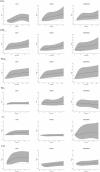Association between ambient air pollution and outpatient visits of cardiovascular diseases in Zibo, China: a time series analysis
- PMID: 39845652
- PMCID: PMC11750768
- DOI: 10.3389/fpubh.2024.1492056
Association between ambient air pollution and outpatient visits of cardiovascular diseases in Zibo, China: a time series analysis
Abstract
Introduction: Facing Mount Tai in the south and the Yellow River in the north, Zibo District is an important petrochemical base in China. The effect of air pollution on cardiovascular diseases (CVDs) in Zibo was unclear.
Methods: Daily outpatient visits of common CVDs including coronary heart disease (CHD), stroke, and arrhythmia were obtained from 2019 to 2022 in Zibo. Air pollutants contained fine particulate matter (PM2.5), inhalable particulate matter (PM10), nitrogen dioxide (NO2), sulfur dioxide (SO2), ozone (O3), and carbon monoxide (CO). Distributed lag non-linear models (DLNM) including single-pollutant model in single-day (lag0-lag7) and cumulative-days (lag01-lag07), concentration-response curve, subgroup analysis, and double-pollutant model were utilized to examine the relationships of daily air pollutants on CHD, stroke, and arrhythmia. Meteorological factors were incorporated to control confounding.
Results: In single-pollutant model, NO2 was positively associated with CHD, stroke and arrhythmia, with the strongest excess risks (ERs) of 4.97% (lag07), 4.71% (lag07) and 2.16% (lag02), respectively. The highest ERs of PM2.5 on CHD, stroke and arrhythmia were 0.85% (lag01), 0.59% (lag0) and 0.84% (lag01), and for PM10, the ERs were 0.37% (lag01), 0.35% (lag0) and 0.39% (lag01). SO2 on CHD was 0.92% (lag6), O3 on stroke was 0.16% (lag6), and CO on CHD, stroke, and arrhythmia were 8.77% (lag07), 5.38% (lag01), 4.30% (lag0). No threshold was found between air pollutants and CVDs. The effects of ambient pollutants on CVDs (NO2&CVDs, PM2.5&stroke, PM10&stroke, CO&stroke, CO&arrhythmia) were greater in cold season than warm season. In double-pollutant model, NO2 was positively associated with CHD and stroke, and CO was also positively related with CHD.
Conclusion: Ambient pollutants, especially NO2 and CO were associated with CVDs in Zibo, China. And there were strong relationships between NO2, PM2.5, PM10, CO and CVDs in cold season.
Keywords: Zibo; ambient air pollutants; arrhythmia; coronary heart disease; stroke.
Copyright © 2025 Wang, Qu, Li, Chen and Yang.
Conflict of interest statement
The authors declare that the research was conducted in the absence of any commercial or financial relationships that could be construed as a potential conflict of interest.
Figures





Similar articles
-
[Impact of ambient air pollution on hospital visits for mental and behavioral disorders among residents in an industrial area in Henan Province from 2016 to 2021].Zhonghua Yu Fang Yi Xue Za Zhi. 2025 Jan 6;59(1):39-52. doi: 10.3760/cma.j.cn112150-20241022-00833. Zhonghua Yu Fang Yi Xue Za Zhi. 2025. PMID: 39607002 Chinese.
-
Association between short-term ambient air pollution and outpatient visits for acute exacerbation of chronic obstructive pulmonary disease in Lanzhou, 2013-19.Environ Geochem Health. 2023 May;45(5):2495-2509. doi: 10.1007/s10653-022-01363-0. Epub 2022 Aug 25. Environ Geochem Health. 2023. PMID: 36006580
-
Association between air pollution and upper respiratory tract infection in hospital outpatients aged 0-14 years in Hefei, China: a time series study.Public Health. 2018 Mar;156:92-100. doi: 10.1016/j.puhe.2017.12.006. Epub 2018 Feb 3. Public Health. 2018. PMID: 29408194
-
Association between exposure to ambient air pollution and hospital admission, incidence, and mortality of stroke: an updated systematic review and meta-analysis of more than 23 million participants.Environ Health Prev Med. 2021 Jan 26;26(1):15. doi: 10.1186/s12199-021-00937-1. Environ Health Prev Med. 2021. PMID: 33499804 Free PMC article.
-
Air Pollution and Temperature in Seizures and Epilepsy: A Scoping Review of Epidemiological Studies.Curr Environ Health Rep. 2024 Dec 10;12(1):1. doi: 10.1007/s40572-024-00466-3. Curr Environ Health Rep. 2024. PMID: 39656387 Free PMC article.
Cited by
-
Joint associations of PM10 and smoking with the risk of new-onset stroke in middle-aged and older adult Chinese adults: findings from the CHARLS cohort study.Front Public Health. 2025 Jun 2;13:1537166. doi: 10.3389/fpubh.2025.1537166. eCollection 2025. Front Public Health. 2025. PMID: 40529701 Free PMC article.
-
The gender difference in the effects of air pollution on the risk of spinal osteoarthritis in Chinese middle-aged and older adults: a prospective cohort study in China.Front Public Health. 2025 Apr 30;13:1576204. doi: 10.3389/fpubh.2025.1576204. eCollection 2025. Front Public Health. 2025. PMID: 40371289 Free PMC article.
-
Association between air pollution and non-accidental mortality in Guiyang, China: a time-series analysis (2013-2023).Front Public Health. 2025 Jul 16;13:1602900. doi: 10.3389/fpubh.2025.1602900. eCollection 2025. Front Public Health. 2025. PMID: 40740351 Free PMC article.
References
MeSH terms
Substances
LinkOut - more resources
Full Text Sources
Medical

